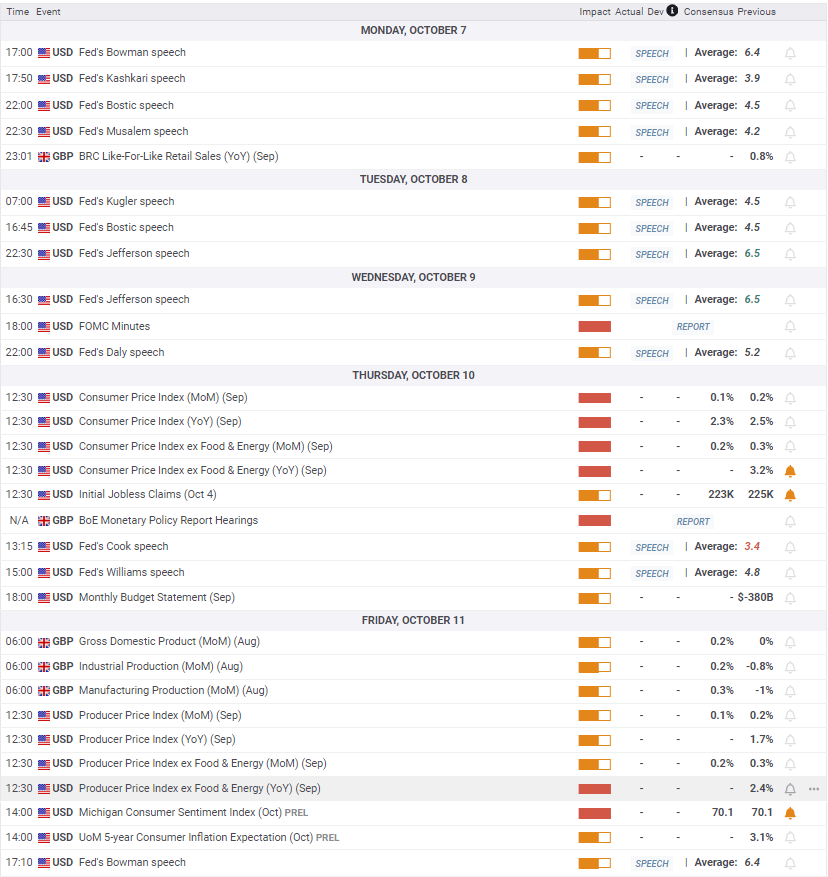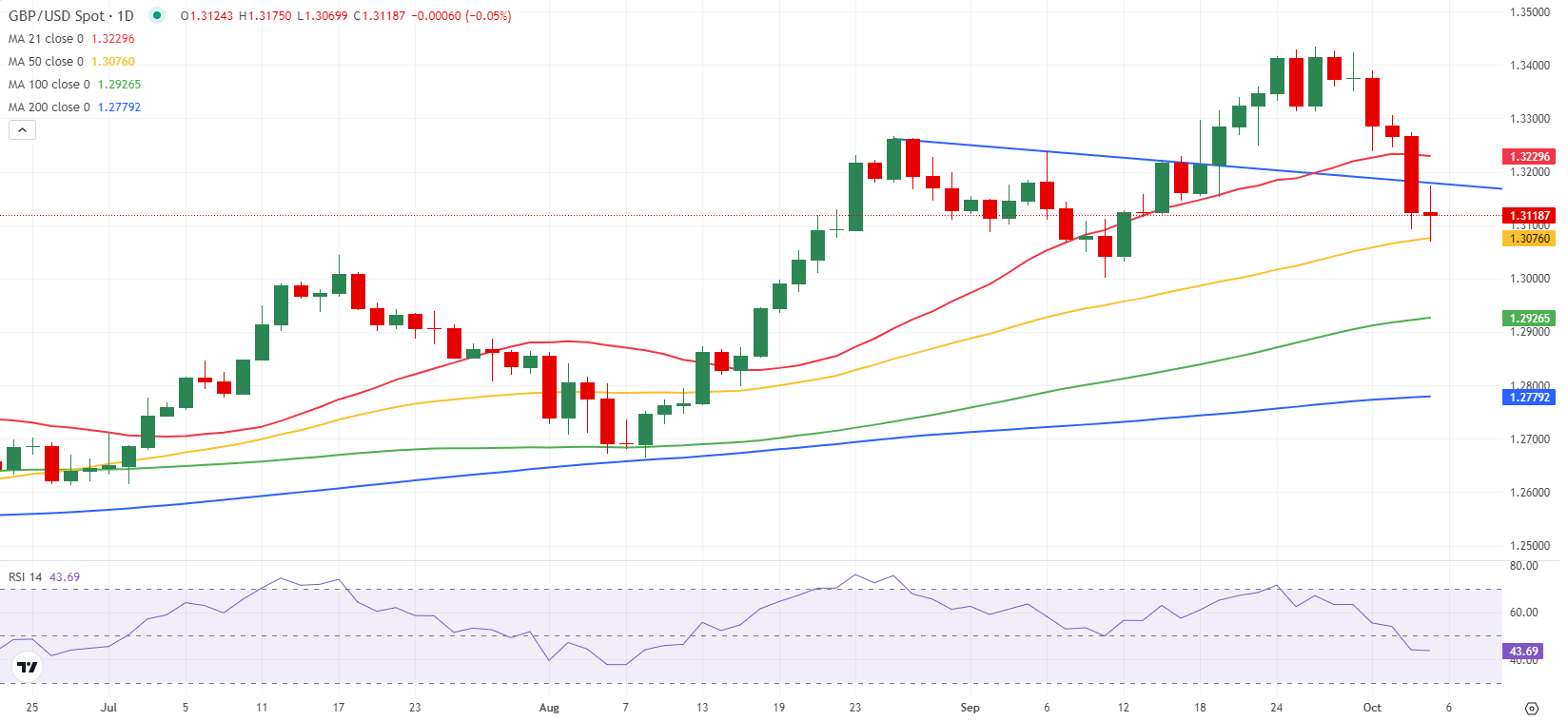- The Pound Sterling extended its correction from 30-month highs against the US Dollar.
- Will US inflation data revive GBP/USD buyers next week?
- Technically, the path of least resistance appears down for the Pound Sterling.
The Pound Sterling (GBP) closed the week deep in the red against the US Dollar (USD), as the GBP/USD extended the correction from 30-month highs to below 1.3100.
Pound Sterling yields into the US Dollar resurgence
GBP/USD failed to sustain at higher levels and returned to negative territory, giving up almost 300 pips in the past week. The pair faced a double whammy, with the resurgence of the demand for the US Dollar on one hand while on the other side, the Pound Sterling was thrown under the bus on the Bank of England’s (BoE) dovish policy expectations and the risk-averse market environment.
The recent slew of strong US economic data, including JOLTS Job Openings, ADP Employment Change and ISM Services PMI poured cold water on bets that the Federal Reserve (Fed) will opt for a 50 basis points (bps) interest rate cut in November, fuelling a sustained recovery in the US Dollar against its major rivals.
Data on Tuesday showed that US Job Openings rebounded to a three-month high in August, arriving at 8.04 million after declining to 7.71 million in July. The Automatic Data Processing (ADP) reported on Wednesday that the US private sector employment increased by 143,000 jobs for September, accelerating from the upwardly revised 103,000 in August and better than the 120,000 estimate.
Meanwhile, US ISM Services PMI jumped from 51.5 to 54.9 in September, above the forecast of 51.7 while marking the highest reading since February 2023. Markets now price in about a 34% chance that the Fed will deliver a big rate cut at its next meeting, compared with almost 60% last week, the CME Group's FedWatch Tool shows.
The Greenback also drew haven demand from mounting risks of the Israel-Iran conflict turning into a wider regional war in the Middle East. Iran conducted missile attacks on Israel to avenge last week’s killings of leaders of the Tehran-back militant group Hezbollah. Israel responded by striking an apartment in central Beirut, which killed nine people. The Lebanese Army returned Israeli fire for the first time in nearly a year of fighting between Israel and Hezbollah.
On the Pound Sterling side of the equation, the prevalent risk aversion continued to remain a weight on the high-beta currency. However, it was BoE Governor Andrew Bailey’s dovish commentary in an interview with The Guardian on Thursday that exacerbated its pain, knocking off the GBP/USD pair to the lowest level in three weeks at 1.3092.
Bailey said that the BoE could become a bit ‘more activist’ on rate cuts if there’s further good news on inflation. Following his remarks, UK money markets suggested about 42 bps of rate cuts to bank rate in the remainder of 2024 versus about 36 bps on Wednesday.
The pair licked its wounds on Friday amid persistent Middle East concerns and the market’s nervousness heading into the US NFP showdown. Nevertheless, GBP/USD turned south in the second half of the day and dropped below 1.3100 as the USD capitalized on the upbeat US data. Nonfarm Payrolls (NFP) in the US rose by 254,000 in September, beating the market forecast of 140,000 by a wide margin. Moreover, August’s NFP increase of 142,000 got revised higher to 159,000.
Watch out for the US consumer inflation data
The early part of the upcoming week is a quiet one until midweek when the Minutes of the Fed’s September meeting will be released on Wednesday. The absence of high-impact economic releases from the UK and the US will put the focus on a flurry of speeches from the Fed policymakers on Monday and Tuesday.
On Thursday, the highly influential US Consumer Price Index (CPI) data will be reported alongside the weekly Jobless Claims. Following the data releases, New York Fed President John Williams is due to participate in a moderated discussion about the economic outlook and monetary policy at Binghamton University.
Friday will feature the monthly Gross Domestic Product (GDP) and Industrial Production data from the UK. The US calendar will see the publication of the Producer Price Index (PPI) and preliminary Michigan Consumer Sentiment and Inflation Expectations data the same day.
Besides, Middle East geopolitical developments will continue to remain on traders’ radars throughout the week, as tensions between Israel and Iran intensify.
GBP/USD: Technical Outlook
As observed on the daily chart, the GBP/USD pair has breached the critical support levels on its corrective decline from over two-and-a-half-year highs of 1.3434 reached last week.
Thursday’s closing below the 21-day Simple Moving Average (SMA) at 1.3230, followed by a sustained break of the falling trendline resistance turned support at 1.3165, empowered sellers further.
Looking ahead, the risks appear skewed to the downside for GBP/USD, as the 14-day Relative Strength Index (RSI) holds its position well below the 50 level, currently near 44.
The immediate support for buyers is aligned at the 50-day SMA at 1.3076. A weekly closing below it would initiate a fresh downtrend toward the 1.3000 psychological mark.
The next bearish target is seen at the 100-day SMA at 1.2926. The last line of defense for buyers is located at 1.2779, the key 200-day SMA.
Conversely, any recovery attempt will likely meet the initial contention area at around 1.3160, the previous falling trendline support now turned resistance.
Acceptance above the 21-day SMA at 1.3230 is needed to negate the near-term bearish bias.
Pound Sterling will then target the 1.3300 round level on the road to recovery, above which the 30-month top of 1.3434 will be back on buyers’ radars.
Pound Sterling FAQs
The Pound Sterling (GBP) is the oldest currency in the world (886 AD) and the official currency of the United Kingdom. It is the fourth most traded unit for foreign exchange (FX) in the world, accounting for 12% of all transactions, averaging $630 billion a day, according to 2022 data. Its key trading pairs are GBP/USD, also known as ‘Cable’, which accounts for 11% of FX, GBP/JPY, or the ‘Dragon’ as it is known by traders (3%), and EUR/GBP (2%). The Pound Sterling is issued by the Bank of England (BoE).
The single most important factor influencing the value of the Pound Sterling is monetary policy decided by the Bank of England. The BoE bases its decisions on whether it has achieved its primary goal of “price stability” – a steady inflation rate of around 2%. Its primary tool for achieving this is the adjustment of interest rates. When inflation is too high, the BoE will try to rein it in by raising interest rates, making it more expensive for people and businesses to access credit. This is generally positive for GBP, as higher interest rates make the UK a more attractive place for global investors to park their money. When inflation falls too low it is a sign economic growth is slowing. In this scenario, the BoE will consider lowering interest rates to cheapen credit so businesses will borrow more to invest in growth-generating projects.
Data releases gauge the health of the economy and can impact the value of the Pound Sterling. Indicators such as GDP, Manufacturing and Services PMIs, and employment can all influence the direction of the GBP. A strong economy is good for Sterling. Not only does it attract more foreign investment but it may encourage the BoE to put up interest rates, which will directly strengthen GBP. Otherwise, if economic data is weak, the Pound Sterling is likely to fall.
Another significant data release for the Pound Sterling is the Trade Balance. This indicator measures the difference between what a country earns from its exports and what it spends on imports over a given period. If a country produces highly sought-after exports, its currency will benefit purely from the extra demand created from foreign buyers seeking to purchase these goods. Therefore, a positive net Trade Balance strengthens a currency and vice versa for a negative balance.
Information on these pages contains forward-looking statements that involve risks and uncertainties. Markets and instruments profiled on this page are for informational purposes only and should not in any way come across as a recommendation to buy or sell in these assets. You should do your own thorough research before making any investment decisions. FXStreet does not in any way guarantee that this information is free from mistakes, errors, or material misstatements. It also does not guarantee that this information is of a timely nature. Investing in Open Markets involves a great deal of risk, including the loss of all or a portion of your investment, as well as emotional distress. All risks, losses and costs associated with investing, including total loss of principal, are your responsibility. The views and opinions expressed in this article are those of the authors and do not necessarily reflect the official policy or position of FXStreet nor its advertisers. The author will not be held responsible for information that is found at the end of links posted on this page.
If not otherwise explicitly mentioned in the body of the article, at the time of writing, the author has no position in any stock mentioned in this article and no business relationship with any company mentioned. The author has not received compensation for writing this article, other than from FXStreet.
FXStreet and the author do not provide personalized recommendations. The author makes no representations as to the accuracy, completeness, or suitability of this information. FXStreet and the author will not be liable for any errors, omissions or any losses, injuries or damages arising from this information and its display or use. Errors and omissions excepted.
The author and FXStreet are not registered investment advisors and nothing in this article is intended to be investment advice.
Recommended Content
Editors’ Picks

EUR/USD stays defensive near 1.1350 as US Dollar looks to stabilize
EUR/USD remains on the back foot for the second consecutive session, trading near 1.1350 in the European trading hours on Tuesday. The pair weakens as the US Dollar attempts to regain stability amid the US-China trade war and growing concerns over US recession. German/ EU data are awaited.

GBP/USD battles 1.3200 after UK jobs data
GBP/USD is defending minor bids near the 1.3200 mark in the early European session on Tuesday. The latest data from the UK showed that Unemployment Rate steadied at 4% in the quarter to February while Average Earnings disappointed, weighing negatively on the Pound Sterling.

Gold price retains its positive bias above $3,200 amid US-China trade war, bearish USD
Gold price regains positive traction as US tariff uncertainty continues to underpin safe-haven assets. Bets for aggressive Fed rate cuts in 2025 keep the USD depressed and also benefit the XAU/USD pair.

XRP resilient amid looming ETF deadlines
Ripple (XRP) flaunted a bullish outlook, trading at $2.1505 at the time of writing on Tuesday. Investor risk appetite has continued to grow since the middle of last week, propping XRP for a sustainable upward move, eyeing $3.0000 psychological level.

Is a recession looming?
Wall Street skyrockets after Trump announces tariff delay. But gains remain limited as Trade War with China continues. Recession odds have eased, but investors remain fearful. The worst may not be over, deeper market wounds still possible.

The Best brokers to trade EUR/USD
SPONSORED Discover the top brokers for trading EUR/USD in 2025. Our list features brokers with competitive spreads, fast execution, and powerful platforms. Whether you're a beginner or an expert, find the right partner to navigate the dynamic Forex market.

